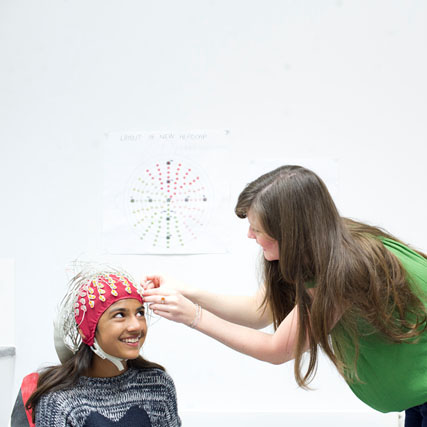The SAAND Study
Paying attention to the world and being able to direct attention toward the right sources of information, are complex but very important abilities that develop very early during life, and are likely to be impaired in individuals with Autism Spectrum Disorder (ASD) and Attention Deficit Hyperactivity Disorders (ADHD). The SAAND study research group, composed of Dr Maddie Groom, Dr Danielle Ropar, Prof Chris Hollis, Iti Arora and Alessio Bellato (University of Nottingham), is investigating these mechanisms in children with ASD and ADHD. We hope that this research will have implications for clinical settings, for example by improving the diagnostic process and leading to new interventions for children with these neurodevelopmental conditions, as well as increasing knowledge about typical and atypical development of attention during childhood. Further, we would like to develop an international network of researchers working with these specific techniques, with the communal aim of improving our understanding about these conditions and, indirectly, the lives of children with ASD, ADHD, and their families.
These two neurodevelopmental conditions, taken together, impact the everyday life of at least 1% of population (American Psychiatric Association, 2013). Few of these children present “pure” symptoms of just one disorder; most show co-occurring symptoms of the other condition as well (Leitner, 2014; Groom et al., 2017; Rommelse et al., 2017). For this reason, we decided to focus on mechanisms involved in both ASD and ADHD, to identify mechanisms that underpin each condition and can help explain why they co-occur so often.

Specifically, we are studying several aspects of attention including arousal regulation, defined as the ability to maintain an optimal state of attention that can be flexibly adapted to suit the environment. Recent findings, in fact, indicate that abnormalities in these mechanisms are likely to be present in both ASD and ADHD. Also, these difficulties may emerge even before the identification of behavioural symptoms and have repercussions on higher-level cognitive and social abilities (Keehn et al., 2013; de Klerk et al., 2014; Johnson et al., 2015). For these reasons, the focus of my PhD project, part of the SAAND study (School of Medicine; University of Nottingham), will be on enhancing understanding of how attentional and arousal regulation processes develop during childhood, and how they interact and are impaired in these disorders. Further, we don’t know yet if difficulties in these domains are shared by ADHD and ASD children, or if they are specific to just one condition.

Children will come to our lab and perform some computerised activities designed to measure what draws their attention, how they direct attention to extract information from their environment, while autonomic (pupil dilation, heart rate), electrophysiological (EEG) and oculomotor measures will be collected. Specifically, we will record visual behaviour using an eye-tracking system, while children perform these assessments, allowing us to measure the trajectory and the speed of eye movements, to infer how they direct and focus attention. Further, collecting brain activity measures through EEG will provide important information about how the brain is functioning to facilitate attention and information processing during the tasks. From this project, we expect to find evidence of the interaction between attentional abilities and arousal regulation difficulties in children with ADHD or ASD, with more deficits in regulating arousal related to more difficulties in controlling attention.
We have just started recruitment of children with a diagnosis of ASD, ADHD or comorbid ASD & ADHD, but also of typically developing children, so we invite you to contact us, in case you are interested in participating in our study, or to share this blog with someone who may be interested.

Conflicts of interest
The author declares that they do have a conflict of interest, since the author is involved in this study and will use data collected from this study towards his PhD project. The views expressed here are those of the author and do not necessarily reflect those of the Association for Child and Adolescent Mental Health.
Links
American Psychiatric Association (2013). Diagnostic and statistical manual of mental disorders: DSM-5.
Discover more articles from The Bridge.
